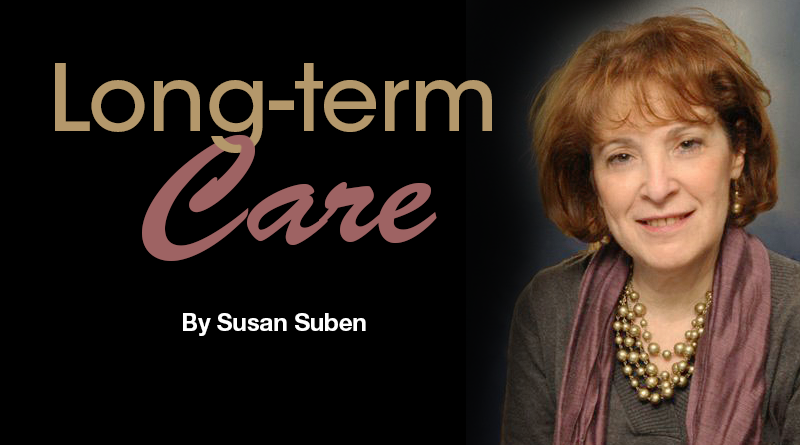The State of The LTC Planning Industry
By Susan Suben
 If my memory is correct, I wrote an article about the long-term care (LTC) planning marketplace two years ago. I’ve always stressed the importance of planning for the sake of your family, so it’s good to know how LTC coverage is performing and what your current options are to protect your future.
If my memory is correct, I wrote an article about the long-term care (LTC) planning marketplace two years ago. I’ve always stressed the importance of planning for the sake of your family, so it’s good to know how LTC coverage is performing and what your current options are to protect your future.
Let’s start with the old standby — LTC insurance. To date, 7.5 million people have purchased coverage. Those who purchased coverage 10 years ago or more have seen premium increases for the same reasons I reported two years ago. Interest rates and lapse ratios remain low. Claims continue to rise. In 2015, the companies paid $8.14 billion in claims. In 2019, they paid $11 billion. This is a 35.11% increase, according to figures from the American Association of Long Term Care Insurance (AALTCI).
Can LTCI pricing be trusted and how stable are premiums on new policies?
Consensus in the market is that LTCI companies have more conservative assumptions and new policies have higher margins. “These factors combine for higher premiums, but also for a lower chance of future rate increases,” according to the AALTCI. If there are to be increases in the future, they will probably be in the 10%-12% range as opposed to the higher increases seen on older policies. Future increases are also more likely to be minimal because the companies now have 20 years of claims data and claim cost assumptions are 25% to 50% higher.
I can attest to the fact that of all my clients who received premium increases only one chose to lapse her policy. Policyholders are holding on to their policies, see the value of the coverage and are using their benefits.
In terms of current policy design, LTCI is considered a safety net. Twenty years ago, policy benefits were geared toward nursing home care, therefore higher daily benefits. Today, benefits are geared toward home care and assisted living. Cadillac policies are dinosaurs. Most individuals select a $150-$250 daily benefit, two to three years coverage with 3% compound inflation. This keeps the premium reasonable.
According to AALTCI, 51.5% of claims begin in the home and 43% end at home. 24.5% begin in an assisted living facility and 26.5% end there. Approximately, 25% begin and end in a nursing home.
The sweet spot to purchase LTCI is still 45 to 64. Individuals aged 50 to 59 have a 21% declination rate; aged 65 to 69, 32.5%; aged 70-74, 44%; and 75 and older, 51.5%, according to AALTCI, based on 2019 figures.
Other statistics include: 59% of women policyholders go on claim; men, 41%. 50% are married; 40% are not married. The leading claim is for Alzheimer’s. The average time between purchasing a policy and going on claim is 13.5 years. 52% go on claim between the ages of 81 and 90, according to AALTCI.
Even though LTC planning still remains a crucial part of retirement planning, individuals shy away from LTCI because they don’t like the idea of paying premiums on a policy they might never use. The marketplace responded to this by introducing an expansive line of life insurance products with LTC components. The sale of these policies has increased dramatically each year.
Hybrids are one such policy. If LTC is not needed, the policy works like a traditional life insurance policy with a tax-free death benefit paid to the beneficiary. They are usually universal or whole life, require a single premium or paid-up option, provide two years of LTC coverage, have same triggers as LTCI, reimburse for actual expenses and require life and LTC underwriting. The death benefit can be leveraged for LTC by adding an extension rider with or without inflation. If you have a CD or received an inheritance that you do not need for retirement, consider using these funds to pay the premium. You may also exchange your current life insurance for this type of policy
The life policies with accelerated death benefit allow you to take 2%, 4% or the federal per diem amount ($11,000) for LTC. They are universal or whole life, have the same triggers as LTCI, and pay cash so anyone can take care of you. They do not have inflation protection and provide approximately two years of LTC coverage. Only life underwriting is required. Consider exchanging your current life policy.
Life insurance policies with chronic illness riders are for individuals with more severe medical conditions. When the death benefit is accelerated for LTC, there is a hefty administrative cost.
LTC planning should be a very important part of your retirement plan. Today’s LTC marketplace is more stable, more creative and more diverse. There is a plan for everyone. You just have to take the time to find the best plan for you.
Susan Suben, MS, CSA, is president of Long Term Care Associates, Inc. and Elder Care Planning. She is a consultant for Canandaigua National Bank & Trust Company. She can be reached at 800-422-2655 or by email at susansuben@31greenbush.com.

